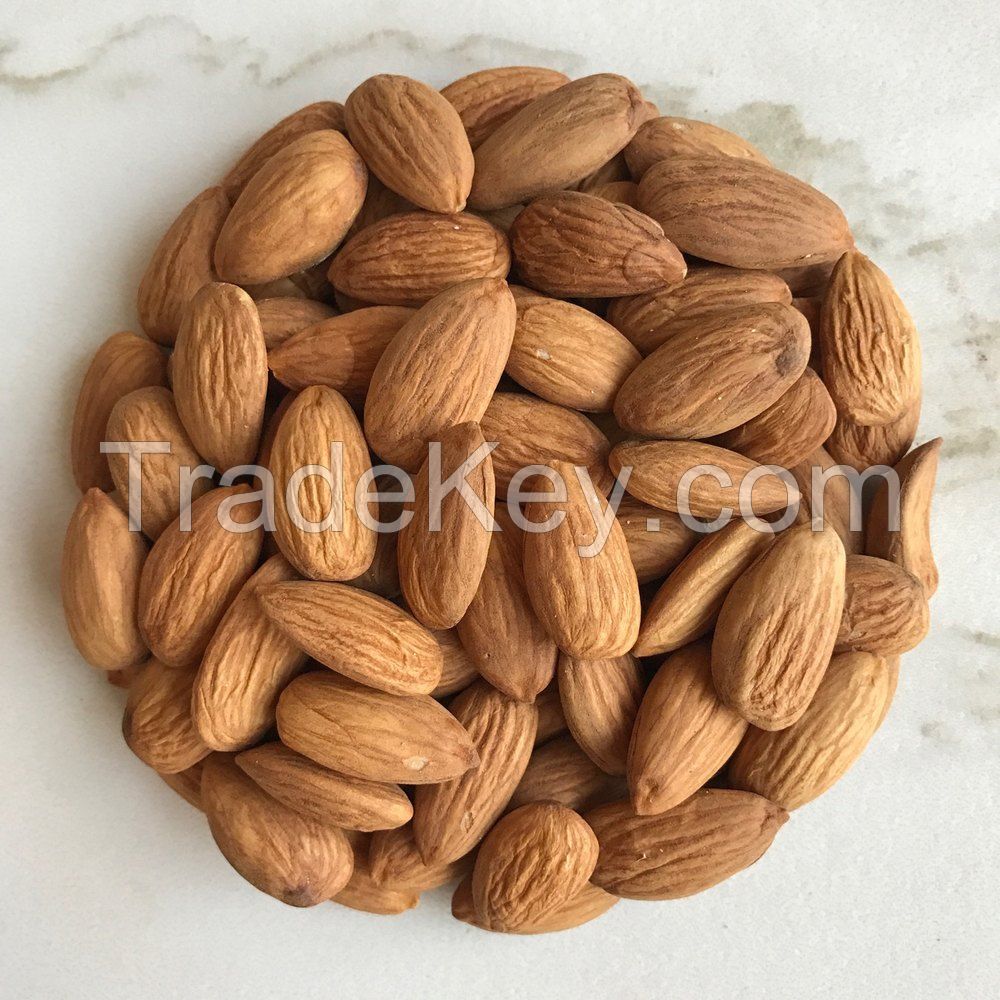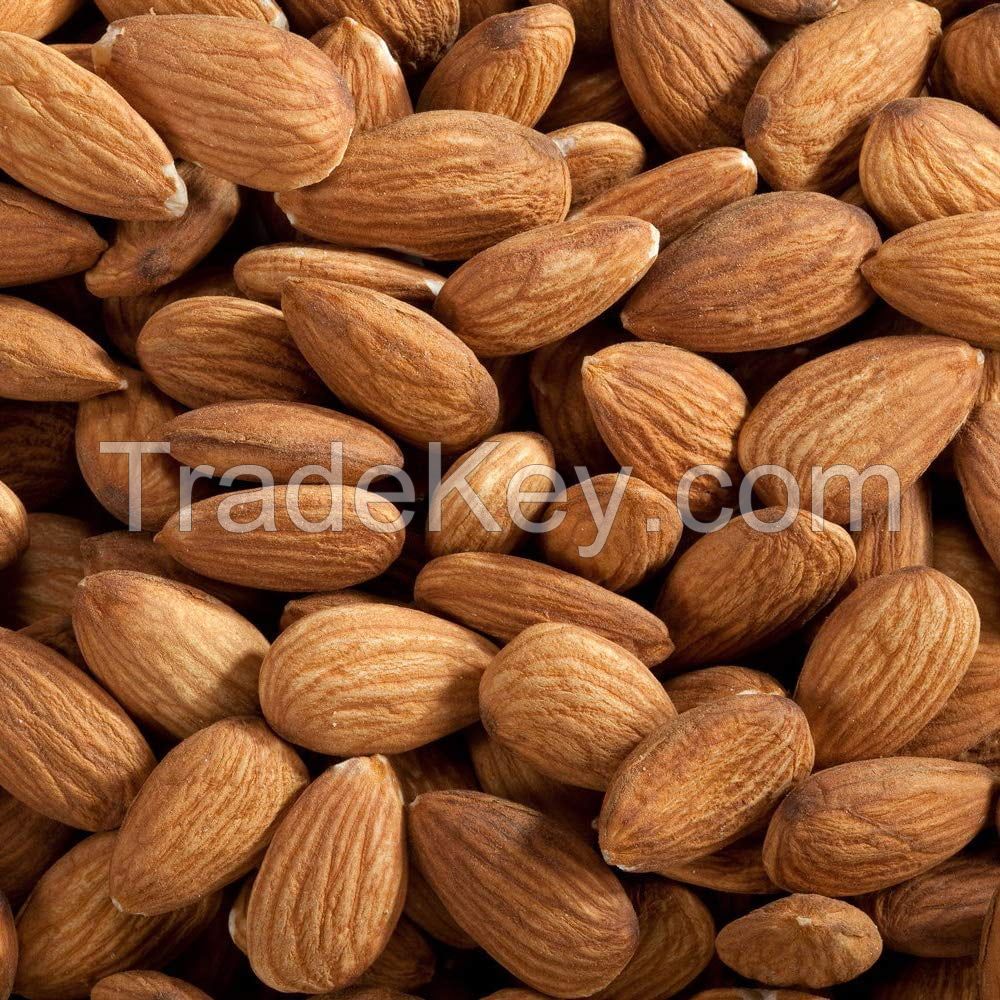الوصف
The almond (Prunus amygdalus, syn. Prunus dulcis) is a species of
tree from the genus Prunus.
Along with the peach, it is classified in the subgenus
Amygdalus,
distinguished from the other subgenera by corrugations on the
shell (endocarp) surrounding the seed.
The fruit of the almond is a drupe, consisting of an outer hull
and a hard shell with the seed, which is not a true nut.
Shelling almonds refers to removing the shell to reveal the
seed.
Almonds are sold shelled or unshelled.
Blanched almonds are shelled almonds that have been treated with
hot water to soften the seedcoat,
which is then removed to reveal the white embryo.
Once almonds are cleaned and processed, they can be stored over
time.
Almonds are used in many cuisines, often featuring prominently in
desserts, such as marzipan.
The almond tree prospers in a moderate Mediterranean climate with
cool winter weather.
Almond is rarely found wild in its original setting.
Almonds were one of the earliest domesticated fruit trees,
due to the ability to produce quality offspring entirely from
seed, without using suckers and cuttings.
Evidence of domesticated almonds in the Early Bronze Age has been
found in the archeological sites of the Middle East,
and subsequently across the Mediterranean region and similar arid
climates with cool winters.
California produces about *0% of the world's almond supply.
Due to high acreage and water demand for almond cultivation, and
need for pesticides,
California almond production may be unsustainable,
especially during the persistent drought and heat from climate
change in the *1st century.
Droughts in California have caused some producers to leave the
industry, leading to lower supply and increased prices.
Description
The almond is a deciduous tree growing to *4.5 metres (***5 feet)
in height,
with a trunk of up to *0 centimetres (*2 inches) in
diameter.
The young twigs are green at first, becoming purplish where
exposed to sunlight, then gray in their second year.
The leaves are **3 cm (*5 in) long,[8] with a serrated margin and
a 2.5 cm (1 in) petiole.
The fragrant flowers are white to pale pink, *5 cm (*2 in)
diameter with five petals,
produced singly or in pairs and appearing before the leaves in
early spring.
Almond trees thrive in Mediterranean climates with warm, dry
summers and mild, wet winters.
The optimal temperature for their growth is between *5 and *0 °C
(*9 and *6 °F)
and the tree buds have a chilling requirement of **0 to **0 hours
below 7.2 °C (*5.0 °F) to break dormancy.
Almonds begin bearing an economic crop in the third year after
planting.
Trees reach full bearing five to six years after planting.
The fruit matures in the autumn, *8 months after flowering.
The almond fruit is 3.*6 cm (1*3⁄*2*3⁄8 in) long. It is not a nut
but a drupe.
The outer covering, consisting of an outer exocarp, or skin, and
mesocarp, or flesh,
fleshy in other members of Prunus such as the plum and cherry, is
instead a thick, leathery,
gray-green coat (with a downy exterior), called the hull.
Inside the hull is a woody endocarp which forms a
reticulated,
hard shell (like the outside of a peach pit) called the pyrena.
Inside the shell is the edible seed, commonly called a nut.
Generally, one seed is present, but occasionally two occur.
After the fruit matures, the hull splits and separates from the
shell,
and an abscission layer forms between the stem and the fruit so
that the fruit can fall from the tree.
During harvest, mechanized tree shakers are used to expedite
fruits falling to the ground for collection.
| بلد: |
France |
| نموذج رقم: |
-
|
| سعر فوب: |
15000 ~ 19000 / Kilogram ( Negotiable ) (قابل للتفاوض)
أحصل على آخر سعر
|
| الموقع: |
France |
| سعر الحد الأدنى للطلب: |
15000 per Kilogram |
| الحد الأدني للطلب: |
1000 Kilogram |
| تفاصيل التغليف: |
Bags |
| موعد التسليم: |
3-5 days |
| القدرة على التوريد: |
500000000 Kilogram per Year |
| نوع الدفع: |
T/T, D/A, Western Union, Money Gram, PayPal |
| مجموعة المنتج : |
- |





